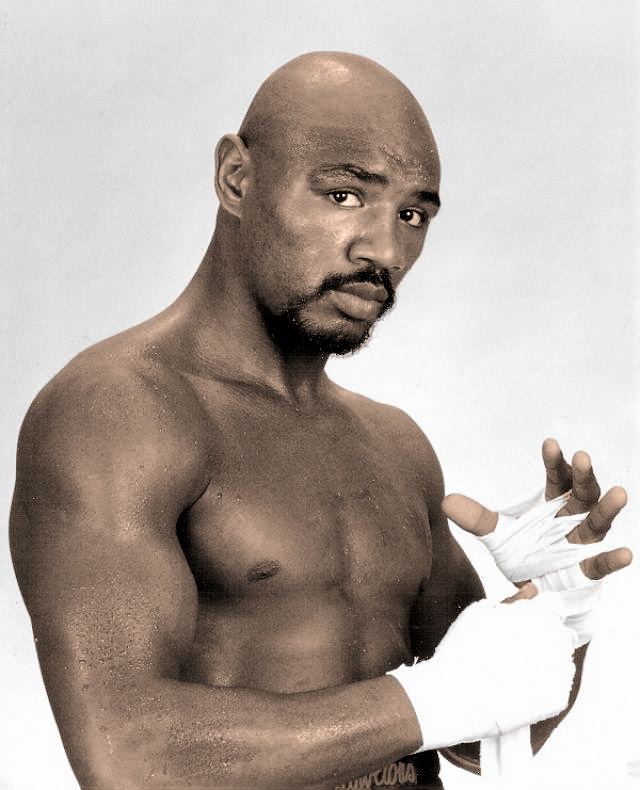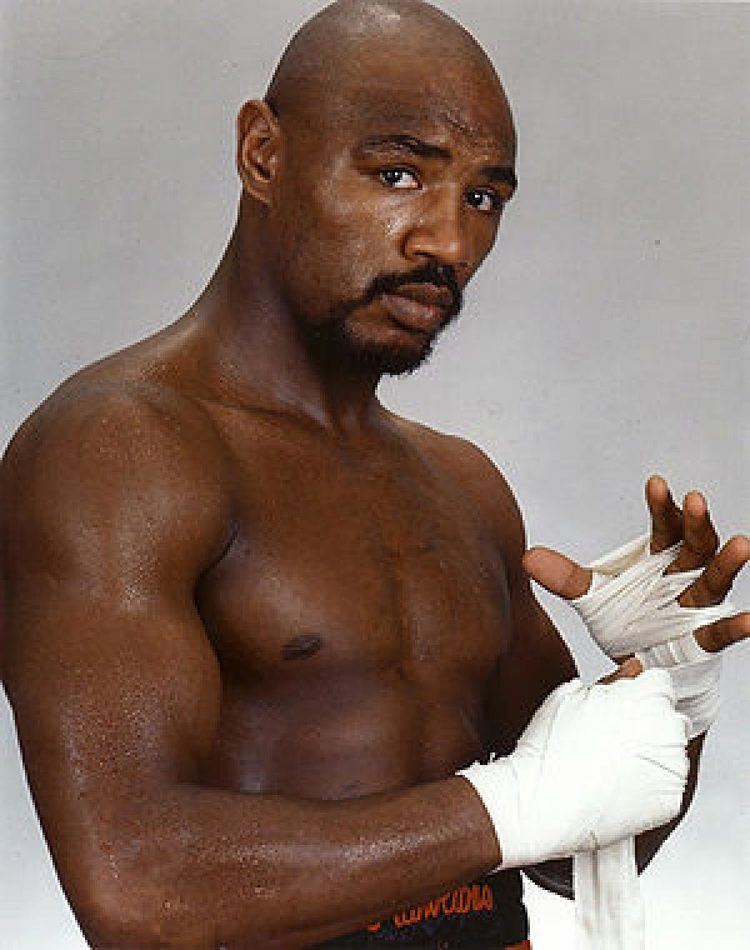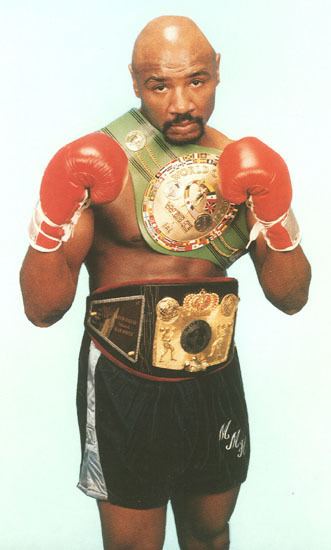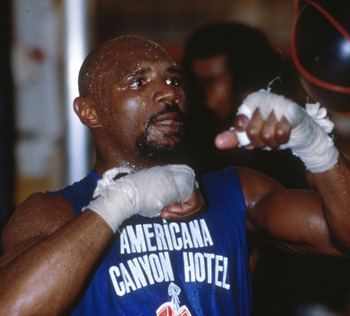Total fights 67 Height 1.77 m Role Professional Boxer | Nationality American Name Marvelous Hagler Reach 75 in (191 cm) Wins 62 Siblings Robbie Sims | |
 | ||
Spouse Kay Guarrera (m. 2000), Bertha Hagler (m. 1980–1990) Children James, Gentry, Marvin, Jr., Celeste, Charelle Parents Ida Mae Hagler, Robert Sims Similar People Thomas Hearns, Sugar Ray Leonard, Roberto Duran, Sugar Ray Robinson, Larry Holmes Profiles | ||
Marvelous marvin hagler tribute 2001
Marvelous Marvin Hagler (born Marvin Nathaniel Hagler; May 23, 1954) is an American former professional boxer who competed from 1973 to 1987. He reigned as the undisputed middleweight champion from 1980 to 1987, making twelve defenses of that title, and currently holds the highest knockout percentage of all undisputed middleweight champions, at 78%. At six years and seven months, his reign as undisputed middleweight champion is the second longest of the last century, behind only Tony Zale, who reigned during World War II. In 1982, annoyed that network announcers often did not refer to him by his nickname, "Marvelous", Hagler legally changed his name to Marvelous Marvin Hagler.
Contents
- Marvelous marvin hagler tribute 2001
- Marvelous Marvin Hagler Reflects On His Career Current Boxers His NVBHOF Induction
- Early life and amateur career
- Early career
- First title shot
- World champion
- Hagler vs Durn
- More title defenses
- Hagler vs Hearns
- Hagler vs Mugabi
- Hagler vs Leonard
- Post fight reaction
- Rematch
- Training style
- Career after boxing
- Personal life
- Awards and recognitions
- References

Hagler is an inductee of the International Boxing Hall of Fame and the World Boxing Hall of Fame. He was named Fighter of the Decade (1980s) by Boxing Illustrated magazine, and twice named Fighter of the Year by The Ring magazine and the Boxing Writers Association of America. In 2001 and 2004, The Ring named him the third greatest middleweight of all time and in 2002 named him the 17th greatest fighter of the past 80 years. The International Boxing Research Organisation rates Hagler as the sixth greatest middleweight of all time, while BoxRec rates him the sixth best middleweight of all time. Many analysts and boxing writers consider Hagler to have one of the best chins in boxing history.

Marvelous Marvin Hagler Reflects On His Career, Current Boxers, & His NVBHOF Induction
Early life and amateur career

Hagler spent his early years in Newark, New Jersey's Central Ward. Following the Newark Riots of July 12–17, 1967, in which 26 people were killed and $11 million in property damage was caused, including the destruction of the Hagler family's tenement, the Haglers moved to Brockton, Massachusetts. In 1969, Hagler took up boxing after walking into a gym in the town owned by brothers Pat and Goody Petronelli, who became his trainers and managers. In 1973, Hagler won the National AAU 165-pound title after defeating Atlanta's Terry Dobbs.
Early career

Hagler was a top-ranked middleweight boxer for many years before he could fight for the title. Hagler struggled to find high-profile opponents willing to face him in his early years. Joe Frazier told Hagler, 'You have three strikes against you, "You're black, you're a southpaw, and you're good.' He often had to travel to his opponents' hometowns to get fights. His first break came when he was offered --on two weeks' notice-- a chance against Willie 'the Worm' Monroe, who was being trained by Frazier. Hagler lost the decision but the fight was close, so Monroe gave him a rematch. This time Hagler knocked out Monroe in 12 rounds. In a third fight, he stopped Monroe in two rounds.
Boston promoter Rip Valenti took an interest in Hagler and began bringing in top ranked opponents for Hagler to face. He fought 1972 Olympics gold medalist Sugar Ray Seales; Hagler won the first time, the second was a draw and Hagler knocked out Seales in the third fight. Number 1 ranked Mike Colbert was knocked out in the twelfth and also had his jaw broken by Hagler. Briton Kevin Finnegan was stopped in eight. Afterwards Finnegan required 40 stitches in his face. He dropped a controversial decision to Bobby 'Boogaloo' Watts, but knocked out Watts in two rounds in a rematch. Hagler won a ten-round decision over 'Bad' Bennie Briscoe. By then, promoter Bob Arum took notice and signed him.
First title shot
In November 1979, Hagler fought World Middleweight Champion Vito Antuofermo at Caesar's Palace in Las Vegas, Nevada. After fifteen rounds, most thought that Hagler had won. Hagler claimed the ref said he won, but the ref denied ever saying it. Hagler claimed he and many others were surprised when the decision was announced as a draw and Antuofermo retained his title. This only added to Hagler's frustrations. Hagler had the boxing skills and killer instinct to knock Vito out, but instead he played it safe and it cost him the title.
World champion
Antuofermo lost his title later to British boxer Alan Minter, who gave Hagler his second title shot. Hagler went to Wembley Arena to face Minter. The tense atmosphere was stoked further when Minter was quoted as saying that "No black man is going to take my title"—Minter would later insist he meant "that black man". Hagler took command and his slashing punches soon opened up the cut prone Minter. The referee halted the contest after 3 rounds. At the conclusion of this bout a riot broke out and Hagler and his trainers had to be carried away to their locker rooms by the police, in the middle of a rain of beer bottles and glasses. After 7 years and 50 fights, Hagler was World Middleweight Champion.
Hagler proved a busy world champion. He defeated future world champion Fulgencio Obelmejias of Venezuela by a knockout in eight rounds and then former world champ Antuofermo in a rematch by TKO in four rounds. Both matches were fought at the Boston Garden near Hagler's hometown, endearing him to Boston fight fans. Syrian born Mustafa Hamsho, who won his shot in an eliminator with Wilfred Benítez and would later defeat future world champion Bobby Czyz, became Hagler's next challenger, put up a lot of resistance but was finally beaten in 11 tough rounds. Michigan fighter William "Caveman" Lee lasted only one round, and in a rematch in Italy, Obelmejias lasted five rounds. British Champion (and mutual Alan Minter conqueror) Tony Sibson followed in Hagler's ever-growing list of unsuccessful challengers. Sibson provided one of the most entertaining (to this point) fights of Marvelous Marvin's career, but he ultimately fell short, lasting six rounds. Next, came Wilford Scypion, who only lasted four. By then, Hagler was a staple on HBO, the Pay Per View of its time.
Hagler vs. Durán
A fight against Roberto Durán followed. Durán was the first challenger to last the distance with Hagler in a world-championship bout. Durán was the WBA Light Middleweight Champion and went up in weight to challenge for Hagler's middleweight crown. Hagler won a unanimous 15-round decision, although after 13 rounds, Duran was ahead by one point on two scorecards and even on the third. Hagler, with his left eye swollen and cut, came on strong in the last two rounds to win the fight.
More title defenses
Then came Juan Roldán of Argentina, who became the only man to be credited with a knockdown of Hagler, scoring one knockdown seconds into the fight – which was clearly a slip to anyone who saw it. Hagler protested bitterly that he had been pulled/pushed to the canvas. Hagler cut Roldan's left eye, then brutalized him over ten rounds and stopping him in the middle of round ten. Sugar Ray Leonard was calling the fight ringside with HBO analyst Barry Tompkins. He noted to Tompkins between rounds that Hagler looked older and slower. "Marvin might finally be slowing down, Barry" Leonard remarked. Many people believe this is the fight that gave Sugar Ray Leonard the idea that he could actually win a fight with the aging Hagler. Hamsho was given a rematch, but the Syrian was again TKO'd, this time in only three rounds. Hamsho angered Hagler with a trio of intentional headbutts in the second round and a fourth early in the third, goading the normally patient and cautious Hagler into a full-out attack that left Hamsho battered and defenseless in a matter of seconds.
Hagler vs. Hearns
On April 15, 1985, Hagler and Thomas Hearns met in what was billed as The Fight; later it would become known as "The War." Hagler, despite a cut to the head and being covered in blood, managed to overpower Hearns in the third round after a glancing right hand followed by two more rights and a left, scoring a decisive knockout. The first round of Hagler vs. Hearns is often considered to be among the best three minutes in boxing in middleweight history as the two fighters stood toe-to-toe trading blows. Rounds two and three couldn't live up to the first, as Hearns broke his hand in the first round, but were still very competitive. The fight only lasted eight minutes but it is rightly regarded as a classic and is considered to this day to be Hagler's greatest achievement. Commentator Al Michaels uttered the now-immortal line, "It didn't go very far, but it was a beauty!" The fight was named "Fight of the Year" by The Ring.
Hagler vs. Mugabi
Next was Olympic silver medalist John Mugabi of Uganda, who was 25–0 with 25 knockouts and was ranked the number one contender by all three major bodies. The fight took place on March 10, 1986 as Hagler had hurt his back and could not fight on the first date booked in 1985. Hagler stopped Mugabi in the 11th round of a brutal fight. Many ringside observers, including analyst Gil Clancy, noticed that Hagler was showing signs of advanced ring wear and age. He was much slower of hand and foot and seemed much easier to hit. He had also completely morphed his ring style from a slick, quick-fisted, boxer/puncher to a strictly flat-footed, stalking, slugger to compensate for his loss of speed and reflexes. Hagler was now said to be seriously considering retirement. Hagler's promoter Bob Arum was quoted as saying he was expecting Hagler to retire in the face of being challenged by Sugar Ray Leonard.
Hagler vs. Leonard
Hagler's next challenger was Sugar Ray Leonard, who was returning to the ring after a three-year retirement (having fought just once in the previous five years.) During the pre-fight negotiations, in return for granting Hagler a larger share of the purse Leonard obtained several conditions which would be crucial to his strategy; a 22x22ft ring, 12oz gloves and the fight was to be over 12—not 15—rounds. Leonard was 2 years younger, had half as many fights, and unbeknownst to Hagler, had engaged in several 'real' fights behind closed doors (i.e. gloves, rounds, a referee, judges and no head gear) in order to shake off his ring rust. The fight took place at Caesars Palace in Las Vegas on April 6, 1987. Hagler was the betting favorite.
Hagler, a natural southpaw, opened the fight boxing out of an orthodox stance. After the quick and slick Leonard won the first two rounds on all three scorecards, Hagler started the third round as a southpaw. Hagler did better, though Leonard's superior speed and boxing skill kept him in the fight. But by the fifth, Leonard, who was moving a lot, began to tire and Hagler started to get closer. As he tired Leonard began to clinch with more frequency (in total referee Richard Steele gave him over 30 warnings for holding, although never deducted a point). Hagler buckled Leonard's knees with a right uppercut near the end of the round, which finished with Leonard on the ropes. Hagler continued to score effectively in round six. Leonard, having slowed down, was obliged to fight more and run less.
In rounds seven and eight, Hagler's southpaw jab was landing solidly and Leonard's counter flurries were less frequent. Round nine was the most exciting round of the fight. Hagler hurt Leonard with a left cross and pinned him in a corner. Leonard was in trouble, then furiously tried to fight his way out of the corner. The action see-sawed back and forth for the rest of the round, with each man having his moments. Round ten was tame by comparison, as the pace slowed after the furious action of the previous round. Clearly tiring, Leonard boxed well in the eleventh. Every time Hagler scored, Leonard came back with something flashier, if not as effective. In the final round, Hagler continued to chase Leonard. He hit Leonard with a big left hand and backed him into a corner. Leonard responded with a flurry and danced away with Hagler in pursuit. The fight ended with Hagler and Leonard exchanging along the ropes. Hagler began dancing in celebration of his performance while Leonard alternately collapsed to the canvas and raised both his arms in triumph. Leonard threw 629 punches and landed 306, while Hagler threw 792 and landed 291.
Hagler later said that, as the fighters embraced in the ring after the fight, Leonard said to him, "You beat me man". Hagler said after the fight, "He said I beat him and I was so happy". Leonard denied making the statement and claimed he only told Hagler, "You're a great champion". HBO cameras and microphones supported Hagler's version of events.
Leonard was announced as winner by split decision, which remains hotly disputed to this day.
Post-fight reaction
Official ringside judge JoJo Guerra, whose 118–110 scorecard was derided in many quarters, commented that:
Judge Dave Moretti, who scored it 115–113 for Leonard:
Lou Filippo, who scored it 115–113 for Hagler and felt that Hagler's bodyshots and aggression earned him the nod, said:
Hugh McIlvanney, commenting in the British Sunday Times and Sports Illustrated:
McIlvanny also referred to Budd Schulberg's contention about a 'compound optical illusion', namely that simply being more competitive than expected meant that Leonard appeared more effective and to be doing more than he actually was. Harry Gibbs, the British judge who ironically had been rejected by the Hagler camp, said he also scored it for Hagler.
Jim Murray, long-time sports columnist for the Los Angeles Times felt that Leonard deservedly got the decision, arguing that Leonard landed more punches and showed better defense and ring generalship, and writing:
The scorecards from the ringside press attest to the closeness of the fight (6–5, 3 drawn) more pundits awarded the fight to Leonard rather than to Hagler, although counting those who scored it even, more felt Hagler deserved to keep his title than did not:
Rematch
Hagler requested a rematch but Leonard chose to retire again (the third of five high-profile retirements announced by Leonard), having said he would do so beforehand. Hagler himself retired from boxing in June 1988, declaring that he was "tired of waiting" for Leonard to grant him a rematch. In 1990, Leonard finally offered Hagler a rematch which reportedly would have earned him $15m, but he declined. By then he had settled down to a new life as an actor in Italy and was now uninterested in boxing. He said "A while ago, yeah, I wanted him so bad, but I'm over that." At the 1994 Consumer Electronics Show Hagler and Leonard had a mock rematch by playing against each other in the video game Boxing Legends of the Ring, and claimed that an actual rematch was being planned.
Training style
Hagler had a unique training regimen in which he would hole up on Cape Cod in motels that had closed for the winter. For his "road work" he would take to the pavement in army boots, declaring running shoes "sissy shoes." He would run much of his route backwards to prepare for movements in the boxing ring.
Career after boxing
After the loss to Leonard, Hagler moved to Italy, where he became a well-known star of action films. His roles include a US Marine in the films Indio and Indio 2. In 1996, he starred alongside Giselle Blondet in Virtual Weapon. Hagler has provided boxing commentary for British television. Another foray into the entertainment field includes work in the video game Fight Night: Round 3.
Personal life
Former middleweight southpaw boxer Robbie Sims is Hagler's half brother. Hagler has five children with his first wife, Bertha: Charelle, Celeste, James, Marvin, Jr., and Gentry. Although he owns a home in Bartlett, New Hampshire, Hagler currently lives in Milan. In May 2000, he married his second wife Kay, an Italian woman, in Pioltello, Italy.
